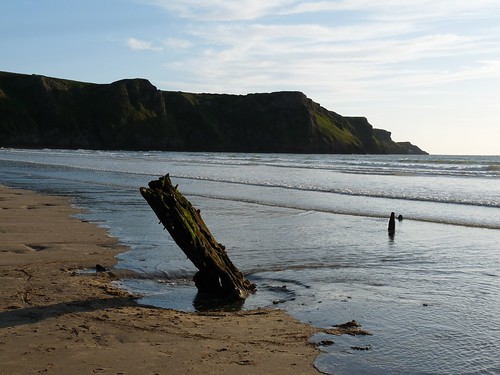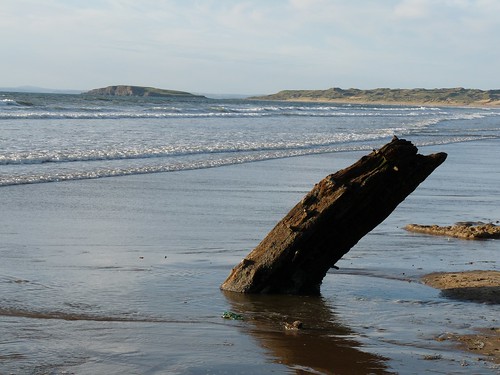Nationality: Norwegian
Location: Rhossili Beach
Date of Wreck: 01/11/1887
Cargo: 500 tonnes of timber
Visible Remains: Wooden hull buried in the sand
The remains of the Norwegian barque Helvetia are one of the most photographed locations on Gower and as a result the most famous shipwreck in the area. It was my curiosity and fascination with these enigmatic remains that originally drew my attention to the other wrecks in the area and led to the creation of this website. As befits such an icon of Gower, the Helvetia has a suitably fascinating story to tell.
On the evening of the 31st October 1887 the Helvetia arrived off the coast at Mumbles on its journey from Campbelton (New Brunswick) to Swansea, and moored up to await a pilot. However, due to the adverse weather conditions of that evening the Bristol Channel proved too rough to navigate to Swansea harbour and the Helvetia was forced to stand down for the evening. By eight o'clock the following morning the wind had strengthened considerably and was reaching gale force levels. The Helvetia now found herself perilously close to the infamous Helwick sand bank off Mumbles. As the wind grew stronger still she was driven across the bank, losing a substantial part of her deck load in the process. Fortunately the crew were able to keep the ship from further damage and rode the waves around Worms Head and into the relative shelter of Rhossili Bay. Here they were were able to drop anchor and wait for the weather to improve. On a better day that would have been the end of the story. The ships captain even went ashore along with the local coastguard believing that all was well.
Unfortunately mother nature is rarely predictable. A few hours later the wind suddenly changed direction and strengthened, ripping the anchor free of the sands and driving the Helvetia perilously close to the expansive sands of Rhossili beach. With a heavy heart the order was given to abandon ship with all of the crew making it safely ashore.
The next day the sands of Rhossili were strewn with the remains of the 500 tonnes of timber cargo that had formerly resided aboard the Helvetia. The ship herself was stranded where she has now lain for the past 122 years. The wood was quickly gathered and sold on to local merchants, while the Helvetia was unceremoniously stripped of anything that had any value. The salvage operation was partly aided by the steamboat Cambria which itself briefly became another casualty of the Gower coastline during the process. But that's a story for another time.
As the years pass the remains of the Helvetia take a battering as successive winter storms do their worst. If you look around the internet you will find pictures where much more of the hull is visible. Some of these timbers have been lost, whilst others remain buried beneath the continually shifting sands of Rhossili beach. I fear that in the not too distant future these photographs may well be all we have left to remember this most famous of wrecks by.
On the evening of the 31st October 1887 the Helvetia arrived off the coast at Mumbles on its journey from Campbelton (New Brunswick) to Swansea, and moored up to await a pilot. However, due to the adverse weather conditions of that evening the Bristol Channel proved too rough to navigate to Swansea harbour and the Helvetia was forced to stand down for the evening. By eight o'clock the following morning the wind had strengthened considerably and was reaching gale force levels. The Helvetia now found herself perilously close to the infamous Helwick sand bank off Mumbles. As the wind grew stronger still she was driven across the bank, losing a substantial part of her deck load in the process. Fortunately the crew were able to keep the ship from further damage and rode the waves around Worms Head and into the relative shelter of Rhossili Bay. Here they were were able to drop anchor and wait for the weather to improve. On a better day that would have been the end of the story. The ships captain even went ashore along with the local coastguard believing that all was well.
Unfortunately mother nature is rarely predictable. A few hours later the wind suddenly changed direction and strengthened, ripping the anchor free of the sands and driving the Helvetia perilously close to the expansive sands of Rhossili beach. With a heavy heart the order was given to abandon ship with all of the crew making it safely ashore.
The next day the sands of Rhossili were strewn with the remains of the 500 tonnes of timber cargo that had formerly resided aboard the Helvetia. The ship herself was stranded where she has now lain for the past 122 years. The wood was quickly gathered and sold on to local merchants, while the Helvetia was unceremoniously stripped of anything that had any value. The salvage operation was partly aided by the steamboat Cambria which itself briefly became another casualty of the Gower coastline during the process. But that's a story for another time.
As the years pass the remains of the Helvetia take a battering as successive winter storms do their worst. If you look around the internet you will find pictures where much more of the hull is visible. Some of these timbers have been lost, whilst others remain buried beneath the continually shifting sands of Rhossili beach. I fear that in the not too distant future these photographs may well be all we have left to remember this most famous of wrecks by.
Location Information:




